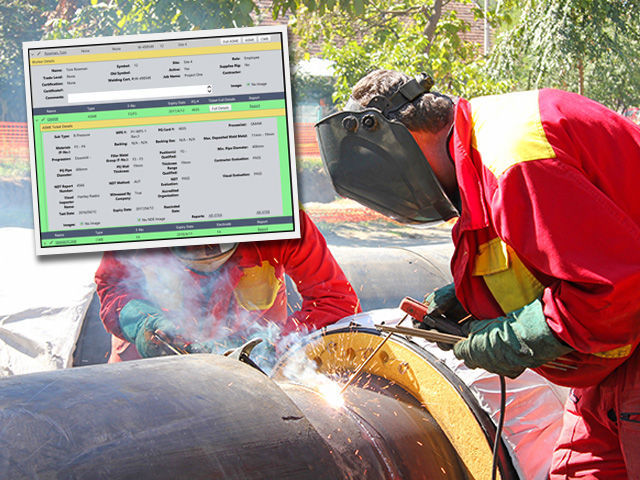Comprehensive Review of Pipeline Welding Inspection Procedures
Pipeline welding examination treatments play a vital function in assuring that bonded links fulfill rigorous market standards and requirements. From thorough pre-welding inspections to extensive post-weld analyses, a distinct evaluation procedure is essential for keeping the structural strength of pipelines.
Pre-welding Assessment Preparations
Before starting the welding procedure, detailed pre-welding inspection prep work are important to make sure the honesty and quality of the weld joint. These preparations involve a careful assessment of the products to be welded, the welding tools, and the job atmosphere. The products must be checked for any type of flaws, pollutants, or incongruities that could compromise the weld. This includes checking for appropriate product qualities, dimensions, and surface problems. Pipeline Welding Inspection. Furthermore, the welding equipment needs to be evaluated to validate that it remains in great functioning condition, calibrated properly, and ideal for the specific welding process. Any type of issues with the equipment ought to be dealt with promptly to avoid defects in the weld. Lastly, the work atmosphere need to be examined for cleanliness, appropriate air flow, and precaution to make certain a favorable setting for the welding operation. By carrying out detailed pre-welding inspection preparations, potential problems can be determined and solved at an early stage, bring about dependable and high-grade weld joints.
Welding Procedure Credentials
Complete pre-welding evaluation prep work lay the structure for the crucial process of Welding Procedure Credentials, making certain the integrity and high quality of the weld joint. Welding Treatment Certification (WPQ) is a vital action in the welding procedure that includes screening and certifying welding treatments to guarantee they fulfill details requirements and needs. The WPQ process commonly includes welding procedure spec development, welding procedure qualification testing, and paperwork of the outcomes.
Throughout welding procedure requirements advancement, crucial information such as the welding process, welding materials, joint design, and welding criteria are defined to create a comprehensive treatment. Consequently, welding treatment qualification screening is conducted to verify the proposed treatment's honesty. This screening frequently entails welding test vouchers that are subjected to different mechanical and non-destructive examinations to assess the weld's quality and adherence to the defined standards.
In-process Weld Inspection
Throughout the welding process, in-process weld examination plays an essential function in ensuring the quality and integrity of the weld joint - Pipeline Welding Inspection. This sort of examination entails checking the welding specifications, evaluating the weld bead development, and spotting any prospective flaws or interruptions as they happen. By performing in-process weld assessments, welding drivers can without delay resolve any type of issues that may emerge, thus ensuring and avoiding further flaws that the last weld meets the required requirements
Typical techniques used for in-process weld assessment include visual inspection, liquid penetrant screening, magnetic particle testing, ultrasonic screening, and radiographic testing. Generally, in-process weld examination is vital for preserving the high quality and integrity of bonded pipes.
Non-destructive Testing (NDT)
Non-destructive Testing (NDT) is a vital approach employed in pipe welding inspection to analyze the stability of weld joints without creating damages to the bonded structure. By using various NDT techniques, inspectors can examine the quality of welds and identify any kind of defects or gaps that might jeopardize the structural sturdiness of the pipe. Common NDT techniques made use of in pipe welding evaluation consist of Radiographic Screening (RT), Ultrasonic Testing (UT), Magnetic Fragment Evaluating (MPT), Fluid Penetrant Screening (LPT), and Visual Screening (VT)
RT involves the use of X-rays or gamma rays to produce images of the interior structure of the weld, allowing assessors to detect problems such as porosity, cracks, or insufficient fusion. Additionally, VT involves aesthetic inspection of welds to determine any noticeable imperfections.
Post-weld Inspection and Documents


Paperwork of post-weld examination findings is important for keeping quality control records and making sure compliance with market requirements and guidelines. In-depth records ought to include information about the assessment approaches utilized, the location and nature of any kind of issues discovered, and any kind of rehabilitative actions taken - Pipeline Welding Inspection. Correct documents not just serves as a record of the weld's top quality however additionally aids in future maintenance and evaluation procedures
Final Thought

Finally, pipe welding evaluation treatments play an essential role in making sure the top quality and integrity of welds. From pre-welding inspections to post-weld documentation, each action is crucial in preserving the security and effectiveness of pipelines. By following recognized treatments and performing comprehensive inspections, possible problems can be recognized and attended to prior to they result in pricey repairs or failings. Generally, adherence to correct assessment procedures is essential to the success of pipeline welding tasks.
From precise pre-welding examinations to detailed post-weld evaluations, a well-defined examination process is essential for preserving the structural stability of pipelines. By conducting in-process weld evaluations, welding operators can promptly deal with any kind of concerns that may arise, thereby protecting her comment is here against additional problems and ensuring that the last weld satisfies the needed specs.
Typical methods utilized for in-process weld evaluation include aesthetic assessment, fluid penetrant testing, magnetic fragment screening, ultrasonic screening, and radiographic screening.Non-destructive Testing (NDT) is an essential technique employed in pipeline welding inspection to evaluate the stability of weld joints without causing damage to the welded structure. Post-weld evaluation includes different approaches to evaluate the welds for problems, including aesthetic webpage evaluation, dye penetrant testing, magnetic fragment testing, ultrasonic screening, and radiographic testing.